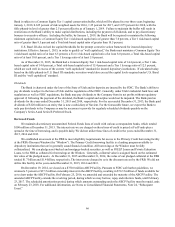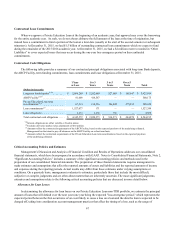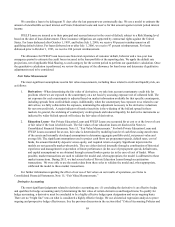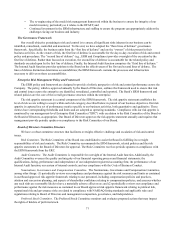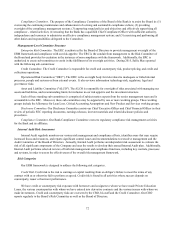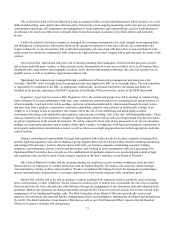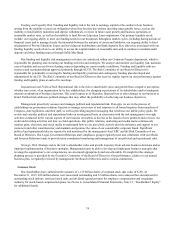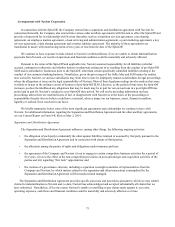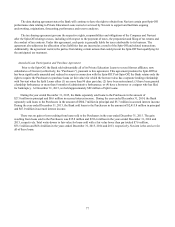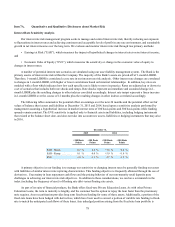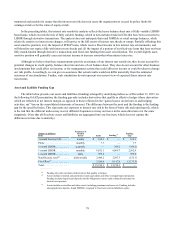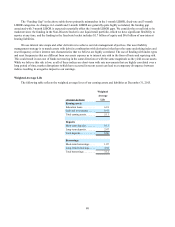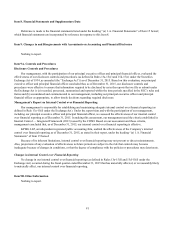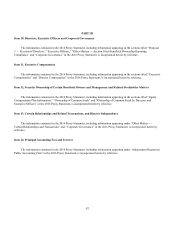Sallie Mae 2015 Annual Report Download - page 76
Download and view the complete annual report
Please find page 76 of the 2015 Sallie Mae annual report below. You can navigate through the pages in the report by either clicking on the pages listed below, or by using the keyword search tool below to find specific information within the annual report.74
Funding and Liquidity Risk. Funding and liquidity risk is the risk to earnings, capital or the conduct of our business
arising from the inability to meet our obligations when they become due without incurring unacceptable losses, such as the
inability to fund liability maturities and deposit withdrawals, or invest in future asset growth and business operations at
reasonable market rates, as well as the inability to fund Private Education Loan originations. Our primary liquidity needs
include: our ongoing ability to meet our funding needs for our businesses throughout market cycles, including during periods of
financial stress and to manage closely the mismatch between the maturity of assets and liabilities; our ongoing ability to fund
originations of Private Education Loans; and servicing our indebtedness and bank deposits. Key objectives associated with our
funding liquidity needs relate to our ability to access the capital markets at reasonable rates and to continue to maintain retail
deposits and other funding sources through Sallie Mae Bank.
Our funding and liquidity risk management activities are centralized within our Corporate Finance department, which is
responsible for planning and executing our funding activities and strategies. We analyze and monitor our liquidity risk, maintain
excess liquidity and access diverse funding sources depending on current market conditions. Funding and liquidity risks are
overseen and recommendations approved primarily through ALCO. The Risk Committee of our Board of Directors is
responsible for periodically reviewing the funding and liquidity positions and contingency funding plan developed and
administered by ALCO. The Risk Committee of our Board of Directors also receives regular reports on our performance against
funding and liquidity plans at each of its meetings.
Reputational and Political Risk. Reputational risk is the risk to shareholder value and growth from a negative perception,
whether true or not, of an organization by its key stakeholders, the changing expectations of its stakeholders and/or inadequate
internal coordination of business decisions. This could expose us to litigation, financial loss or other damage to our business or
brand. Political risk addresses political changes that may affect the probability of achieving our business objectives.
Management proactively assesses and manages political and reputational risk. Post-spin, we are in the process of
establishing our government relations function to manage our review of and response to all formal inquiries from members of
Congress, state legislators, and their staff, as well as providing targeted messaging that reinforces our public policy goals. We
review and consider political and reputational risks on an integrated basis in connection with the risk management oversight
activities conducted in the various aspects of our business on matters as diverse as the launch of new products and services, our
credit underwriting activities and how we fund operations. Our public relations, marketing and media teams continuously
monitor print, electronic and social media to understand how we are perceived; actively provide assistance and support to our
customers and other constituencies; and maintain and promote the value of our considerable corporate brand. Significant
political and reputational risks are reported to and monitored by the management-level ERC and the Risk Committee of our
Board of Directors. Our Legal, Government Relations and Compliance groups regularly meet and collaborate with our Media
and Investor Relations teams to provide more coordinated monitoring and management of our political and reputational risks.
Strategic Risk. Strategic risk is the risk to shareholder value and growth trajectory from adverse business decisions and/or
improper implementation of business strategies. Management must be able to develop and implement business strategies that
leverage the organization’s core competencies, are structured appropriately and are achievable. Oversight for this strategic
planning process is provided by the Executive Committee of the Board of Directors. Our performance, relative to our annual
business plan, is regularly reviewed by management, the Board of Directors and its various committees.
Common Stock
Our shareholders have authorized the issuance of 1.125 billion shares of common stock (par value of $.20). At
December 31, 2015, 426 million shares were issued and outstanding and 52 million shares were unissued but encumbered for
outstanding stock options, restricted stock units and dividend equivalent units for employee compensation and remaining
authority for stock-based compensation plans. See Notes to Consolidated Financial Statements, Note 12, “Stockholders' Equity”
for additional details.




